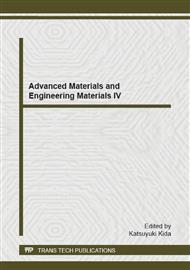[1]
R. A. Grange, E. R. Shackelford, U.S. Patent 3, 178, 324. (1965).
Google Scholar
[2]
R. A. Grange, Metallurgical and Materials Trans. A, Vol. 2, pp.65-78. (1971).
Google Scholar
[3]
H. Koike, E. C. Santos, K. Kida, T. Honda and J. Rozwadowska, Effect of Repeated Induction Heating on Fatigue Crack Propagation in SAE 52100 Bearing Steel, Advanced Material Research, Vol. 217-218, pp.1266-1271. (2011).
DOI: 10.4028/www.scientific.net/amr.217-218.1266
Google Scholar
[4]
E. C. Santos, K. Kida, T. Honda, J. Rozwadowska, K. Houri and K. Hashimoto, Influence of Cyclic Heat Treatment and Oxygen Content on the Rolling Contact Fatigue of JIS SUJ2 Bearings, Advanced Material Research, Vol. 217-278, pp.982-987. (2011).
DOI: 10.4028/www.scientific.net/amr.217-218.982
Google Scholar
[5]
M. Koga, E. C. Santos, T. Honda, K. Kida and T. Shibukawa: Investigation of wear in induction–heated AISI E 52100 steel bars under reciprocating motion, International Journal of Materials and Product Technology 44 (3/4), pp.240-251. (2012).
DOI: 10.1504/ijmpt.2012.050185
Google Scholar
[6]
K. Mizobe, T. Honda, H. Koike, E. C. Santos, T. Shibukawa and K. Kida, Relationship between repeatedly quenching and fisheye cracks around TiN and Al2O3 inclusions in high carbon bearing steel, Material Research Innovations, Vol. 18 (Supplement 1), pp. S60-S65. (2014).
DOI: 10.1179/1432891713z.000000000355
Google Scholar
[7]
K. Nakane, E. C. Santos, T. Honda, K. Mizobe and K. Kida, Homology Analysis of Structure of high carbon bearing steel: Effect of Repeated quenching on Prior Austenite Grain Size, Materials Research Innovations, Vol. 18 (Supplement 1), pp.33-37. (2014).
DOI: 10.1179/1432891713z.000000000353
Google Scholar
[8]
M. Arkowiz, Introduction to homotopy theory (universitext), London, Springer Press. (2011).
Google Scholar
[9]
A. Dold, Lectures on algebraic topology in Classics in mathematics, Berlin, Springer-Verlag. (1995).
Google Scholar
[10]
Hatcher, Algebraic topology, Cambridge, Cambridge University Press. (2001).
Google Scholar
[11]
S. V. Matveev, Lectures on algebraic topology in EMS Series of lectures in mathematics, Zurich, European Mathematical Society. (2006).
DOI: 10.4171/023
Google Scholar
[12]
K. Nakane, K. Mizobe and K. Kida, Homology estimate of grain size easurement based on the JIS samples, Advanced Materials Research, Vol. 813, pp.120-123. (2013).
DOI: 10.4028/www.scientific.net/amr.813.120
Google Scholar
[13]
K. Nakane, Y. Tsuchihashi and N. Matsuura, A simple mathematical model utilizing topological invariants for automatic detection of tumor areas in digital tissue images, Diagn Pathol. Vol. 8 (Suppl 1), S27. (2013).
DOI: 10.1186/1746-1596-8-s1-s27
Google Scholar
[14]
E. C. Santos, K. Kida, T. Honda, H. Koikea and J. Rozwadowska, Fatigue strength improvement of AISI E52100 bearing steel by induction heating and repeated quenching, Mater. Sci., 47(5), p.677–682. (2012).
DOI: 10.1007/s11003-012-9443-8
Google Scholar
[15]
CHomP (Computational Homology Project), http: /chomp. rutger-s. edu.
Google Scholar
[16]
T. Kaczynski, K. Mischaikow and M. Mrozek, Computational homology, Applied Mathematical Sciences', Vol. 157, Heidelberg, Springer-Verlag. (2004).
DOI: 10.1007/b97315
Google Scholar


